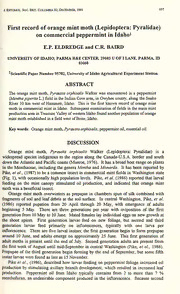
First record of orange mint moth (Lepidoptera: Pyralidae) on commercial peppermint in Idaho PDF
Preview First record of orange mint moth (Lepidoptera: Pyralidae) on commercial peppermint in Idaho
J.ENTOMOL.SOC.BRJT.COLUMBIA92,DECEMBER, 1995 107 First record of orange mint moth (Lepidoptera: Pyralidae) on commercial peppermint in Idaho^ E.P. ELDREDGE and C.R. BAIRD UNIVERSITY OFIDAHO, PARMAR&E CENTER, 29603 UOFILANE, PARMA, ID 83660 ^ScientificPaperNumber95702, UniversityofIdaho Agricultural Experiment Station. ABSTRACT The orange mint moth, Pyrausta orphisalis Walker was encountered in a peppermint (MenthapiperitaL.) field inthe Indian Cove area, in Owyhee county, along the Snake River 10 km west ofHammett, Idaho. This is the first known record oforange mint moth in commercial mint in Idaho. Subsequent examination offields in the main mint productionareainTreasure ValleyofwesternIdahofoundanotherpopulationoforange mintmoth established ina fieldwestofBoise, Idaho. Keywords: Orangemintmoth,Pyraustaorphisalis,peppermintoil, essential oil. DISCUSSION Orange mint moth, Pyrausta orphisalis Walker (Lepidoptera: Pyralidae) is a widespread species indigenous to the region along the Canada-U.S.A. border and south down the Atlantic and Pacific coasts (Munroe, 1976). It has abroad host range on plants in the Menthaceae, including the generaMentha andMonarda. It has been reported by Pike, etal., (1987) to be a common insect in commercial mintfields in Washington state (Fig. 1), with occasionally high population levels. Pike, et ai (1986) reported that larval feeding on the mint canopy stimulated oil production, and indicated that orange mint mothwas abeneficial insect. Orange mint moth overwinters as prepupae in chambers spun of silk combined with fragments ofsoil and leafdebris at the soil surface. In central Washington, Pike, et al. (1986) reported pupation from 20 April through 20 May, with emergence of adults beginning 5 May. There are three generations per year with oviposition of the first generationfrom 10 May to 10 June. Matedfemales lay individual eggs on new growth at the shoot apices. First generation larvae feed on new foliage, but second and third generation larvae feed primarily on inflorescences, typically with one larva per inflorescence. There are five larval instars; the first generation begin to form prepupae around 10 June, and adults emerge on approximately 25 June. This first generation of adult moths is present until the end ofJuly. Second generation adults are present from the first week ofAugust until mid-September in central Washington (Pike, et al, 1986). Prepupae ofthe third generation begin forming by the end of September, but some fifth instar larvae were found as late as 15 November. Pike et al., (1986), described how larvae feeding on peppermint foliage increased oil production by stimulating axillary branch development, which resulted in increased leaf % production. Peppermint oil from Idaho typically contains from 2 to more than 7 menthofuran, an undesirable component produced in the inflorescence. Because second 108 J.ENTOMOL.SOC.BRIT.COLUMBIA92,DECEMBER, 1995 and third generation orange mint moth larvae feed on and consume inflorescences, their presence in the crop could reduce the percentage of menthofuran. Consequently, the orange mint moth might benefit mint oil production both by improving its quality and its quantit}'. Figure 1. Range of orange mint moth (OMM) Pyrausta orphisalis (Pyralidae) in commercial mintgrown in the PacificNorthwest. The first orange mint moth was captured in a peppermint field 10 km west of Hammett, Idaho (Fig. 1). At approximately 10 a.m. on 23 Sept., 1994 the adult moth was seen flying above the canopy and was collected for identification. Field searches were therefore initiated in the main mint production area in Canyon and Ada counties in southwestern Idaho, west and south ofBoise. On 27 Sept. two more orange mint moths were collected in a field 11 km west of Boise in a field of second-year peppermint. Subsequent searches in fields detected no additional locations where the moth could be found. Return visits to the field near Boise resulted in 4 more moths netted on 28 Sept., 11 on 29 Sept., and 6 on 4 Oct. A return visit to the original field on 7 Oct. resulted in collection of6 more moths. Specimens were sent for identification and preservation to the entomology collections at Albertson's College of Idaho, Caldwell; the University of Idaho, Moscow; and the Irrigated Agriculture Research and Extension Center, Prosser, Washington. Dr. Keith Pike (Prosser) confirmed the identification of the specimens (personal communication) as orange mint moth, Pyrausta orphisalis Walker (Lepidoptera: Pyralidae). The University of Idaho entomological museum contained orange mint moth specimens collected from Wallace, Idaho, probably associated with wild mint. The Wallace, Idaho area has neverbeen a site ofcommercial mint production. It is not known how widespread orange mint moth is in Idaho mint production. The insect has probably been present for some time and is established on wild mints. Applications of insecticides to mint during spring to control cutworms (Euxoa and Peridroma spp.), during summer to control loopers (Autographa and Trichoplusia spp.). J.ENTOMOL.SOC.BRTT.COLUMBIA92,DECEMBER, 1995 109 or post-harvest to control mint root borer (Fumibotys fumalis Guenee; Lepidoptera: Pyralidae) could suppress orange mint moth populations. Winter tillage, although not usually done in Idaho from fear of spreading Verticillium wilt, would also suppress the moth. The orange mint moth is an active and evasive flier. They take wing well ahead ofa person walking through the mint field, and after a brief, erratic flight, dive into the canopy, so they are unlikely to be discovered in sweep net sampling. Adult moths are mm approximately 15 overall length (Campbell and Pike, 1984), so they are smaller than mint root borer moths, and may escape observation by persons unfamiliar with orange mint moth. More research is needed to determine the distribution and abundance ofthe moth in Idaho. REFERENCES Campbell, C.L., and K.S. Pike, 1984. Descriptions ofthe life stagesofPyrausta orphisalis(Lepidoptera: Pyralidae). Pan-PacificEntomol. 60:332-336. Munroe, E. 1976. Pyraloidea(in part), pp. 119-120, fasc. 13-28. hv. R.B. Dominick, D.C. Ferguson, J.G. Franclemont, R.W. Hodges, andE.G. Munroe, [eds.].ThemothsofAmericanorth ofMexico. Curwen, London. Pike, K.S., C.L.Campbell,andD.W.Allison. 1986. Orangemintmoth: a beneficial insectin Washington's commercialmints. WashingtonStateUniv. Res. Bull.0982, 8pp. Pike, K.S., D.W. AJlison, and C.L. Campbell. 1987. Effects of Pyrausta orphisalis (Lepidoptera: Pyralidae) on plant growth and oil yield in scotch spearmint, native spearmint, and peppermint. J. Econ. Entomol. 80:69-72.
